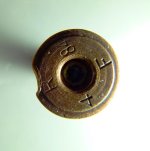Not to brag but...
How many of you guys ever been up on the Crows Nest?
Where Custer's scouts spotted the "encampment" from a long ways
off?
I was fortunate enough to with my hunting buddy back in mid 90's

Me many moons ago at the marker up on top of the hill.
I drove my 4 wheel drive Chevy all the way to the top.
If you enlarge you can read it.

An interesting marker the brothers showed us just down the hill
from the Crows Nest on the trail towards the encampment.
Brass about 12" across mounted in cement right on the ground.
Reads----General George A, Custer and the 7th Cav.
crossed the divide at this point June 25th ??? (can't read it
and can't remember) 1876.

Top pix is myself and the two brothers (ranchers that we met and offered
to show us how to find it). The brothers were both in their 80's and
lived together on the same ranch. Neither ever married.
Bottom pix. is my buddy Bob and one of the brothers.
These two pixs are us standing where the best view was towards
the battlefield. Gave me chills. So i had a cold beer or two up
there and on the ride back out.
We had been on a P-dog shooting trip on the Rosebud in S.Central
South Dakota and the weather was unbearably hot.
As we sat in the shade of our truck sitting on a hot dry prairie
i looked over at Bob and said, lets go. There's no dogs out cause
it's too darn hot. We loaded up our guns and shooting benches
and took off for the Battlefield.
My buddy had been reading about the Battle and some cool
locations to try and visit. we decided we'd try to get to the
Crows Nest. Got to the area it supposed to be and darned if we
didn't see one of the brothers on a tractor pulling into his barn.
We pulled in and introduced ourselves and they made us feel
right at home. We all stood around and had a cold one or two after
offering our cooler contents to the guys. They were very nice and
said they had been living on that ranch their whole lives.
We explained to them we were trying to find the Crows Nest and
Bill the older brother chimed in that, "heck we been up there many
times". The rub is, it's on private property....... but we know who
owns it and they don't mind if you run up there if we sent ya'.
He then began to instruct us on how far down this dirt trail and
veer left here, and hit this switchback here...etc
when i chimed in....why don't you fellas just hop in the truck and
guide us up there. We will supply all the beer and lets just take
a run up there. Bill and Bob agreed and we loaded up into my
truck and off we went. After about 7 miles of off-roading Bill
pointed to a Hill/Ridge that was to our left. He pointed me to
the trail and after 10 minutes or so of straddling some deep
cuts in the trail going up, we made it to the top.
We relaxed and took photos and had a beer, right up on the actual
Crows Nest on a hot afternoon with two guys we had met an hour
ago.
I'll never forget that day.
Chuck




